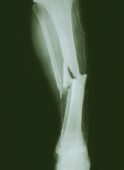
WEDNESDAY, March 24 (HealthDay News) — New research concludes that widely used osteoporosis drugs called bisphosphonates do not boost women’s risk for an unusual type of femur or thigh fracture — something prior studies had suggested.
Bisphosphonates include blockbuster medications such as Boniva (ibandronate), Fosamax (alendronate) and Reclast (zoledronic acid).
Among women using these drugs, “the rate [of this type of fracture] was really low, overall about 2.3 per 10,000 person-years in women with osteoporosis,” said the study’s lead author, Dennis M. Black, a professor of epidemiology and biostatistics at the University of California, San Francisco.
The study, which is published in the March 25 issue of the New England Journal of Medicine, was funded by the pharmaceutical companies Novartis and Merck, which both make bisphosphonates. Study authors also reported ties with various drug makers.
Black said he couldn’t rule out that the medications might cause this type of injury. But, even so, he said, the value of taking them would still exceed any risks.
“The risk-benefit is still very much in favor of using these drugs for a woman who has osteoporosis,” he said. “This is not an epidemic. It’s still uncommon.”
J. Edward Puzas, a professor of orthopedics and director of orthopedic research at the University of Rochester Medical Center in New York, took a similar stance. “There is absolutely no reason and no evidence to stop this medication based on the fact of these unusual fractures,” he said.
“The chance of breaking a bone because of osteoporosis and all the subsequent consequences are so much more severe than these rare instances of a fracture that we don’t even know are caused by bisphosphonates,” Puzas said. “People should not discontinue this medication based on what we’re talking about right now.”
In the study, the authors analyzed data from three large, randomized trials that involved Fosamax and Reclast.
In all, the trials included 14,195 women.
Of 284 fractures occurring in the hip, only 12 fractures in 10 women met the criteria for this type of injury, Black noted. That meant his team could find no significant association between the drugs and the fractures, even among women who had been treated for as long as a decade.
In contrast, the authors calculated that treating 1,000 women with osteoporosis for three years with a bisphosphonate would prevent about 100 bone breaks, including 11 in the hip.
One clinician, however, was cautious in his interpretation of the results, though still advising women to stay the course.
“The message to patients and doctors is the same. We have not established a definitive causal link,” said Dr. Kenneth Egol, a professor and vice chairman of orthopedic surgery at the New York University Hospital for Joint Diseases. “However, there certainly have been an increasing number of cases that we as clinicians are seeing in patients who are on these medications who sustained [this type of fracture].”
“Patients and physicians need to be aware of these potential risks when making decisions on which medications to take for osteoporosis,” Egol said.
Osteoporosis afflicts some 10 to 12 million people in the United States and carries with it a high risk of debilitating fractures, which can, in rare cases, lead to fatal complications.
Bisphosphonates are the main class of drugs used to treat the condition. All drugs in the class have been shown to reduce the risk of osteoporotic fractures and, in general, Black said, they have a good overall safety profile.
But in recent months, the news media has been filled with case reports of people with osteoporosis taking one of the drugs and then sustaining unusual fractures of the upper thigh.
Two scientific studies have also linked long-term use of bisphosphonates with the problem.
“It’s an unusual type of thigh fracture, and they seem to occur with very little trauma — maybe the person was just walking or turned and heard a crack and fell,” Black explained. “They’re the kind of fractures we would typically see in a motorcycle accident but [are seeing in the newer cases] with very low trauma.”
Researchers will no doubt continue to study the issue, Puzas said.
“We are going to look more closely at the biology of this,” he said. “Is there anything that could potentially account for rare and unusual fractures? If we can find a reason why bones behave [in a way] that could explain fractures, that would go a long way to explain whether this is real or not.”
More information
There’s more on medications to prevent and treat osteoporosis at the National Osteoporosis Foundation.

